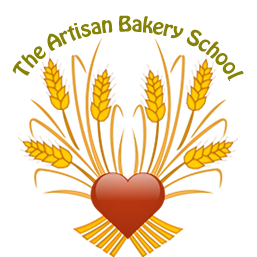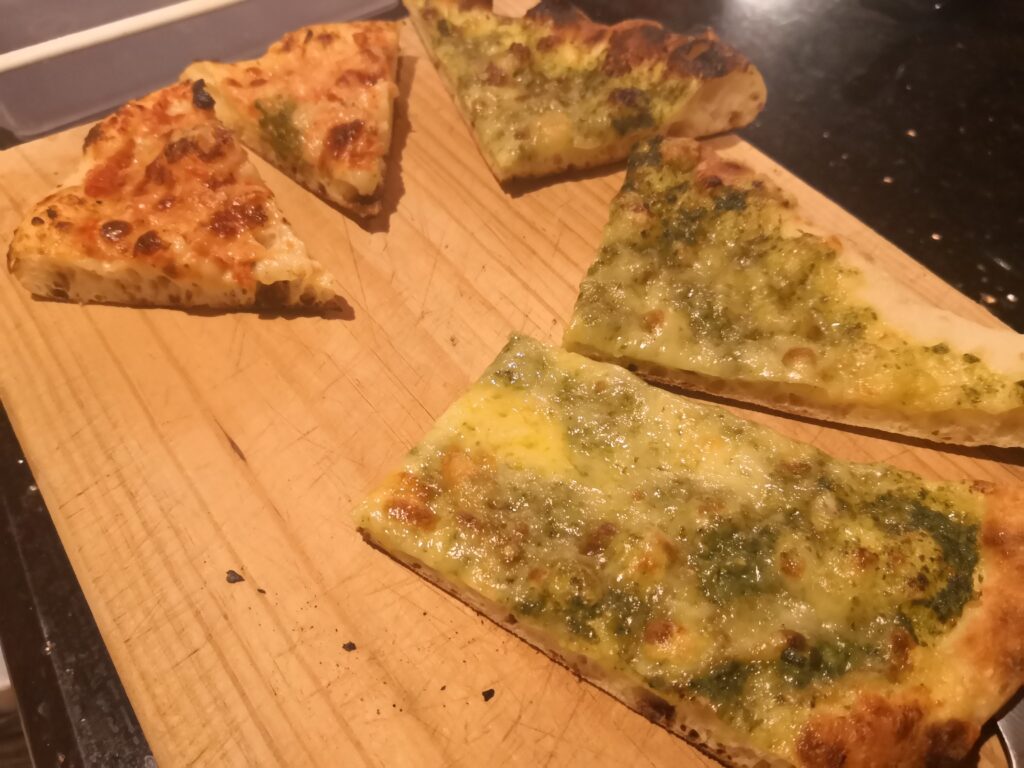Petit fours to love and share this Christmas.
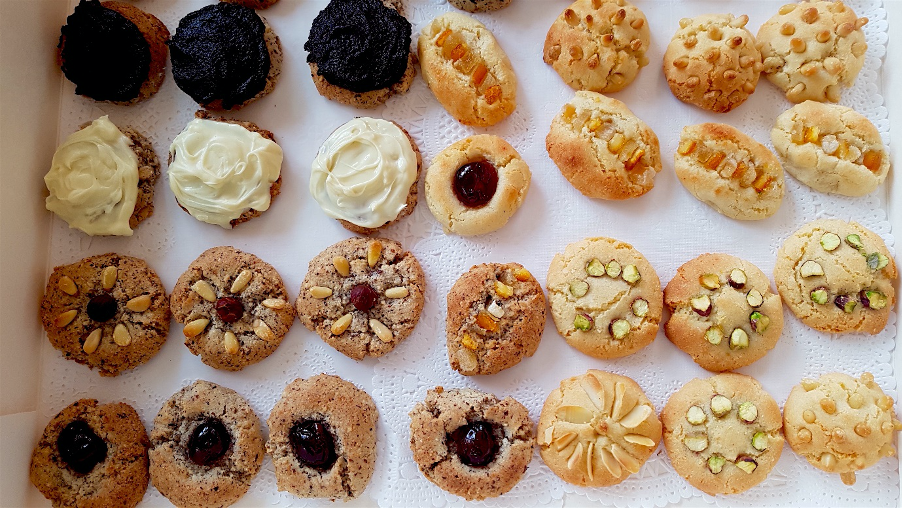
Make these as simple or as fancy as you like; they are unfailingly delicious. And a pretty box turns them into a delightful last minute gift.
Dough ingredients
- 200g ground almonds or freshly ground hazelnuts (coffee grinder works fine for this)
- 100g caster sugar
- 100g icing sugar (sifted)
- 1 large egg (beaten)
Method
- Mix the sugars with the ground nuts, then add the beaten egg.
- It will look impossibly dry at first, but keep mixing with a spatula, then you will find it becomes a ball you can knead slightly.
- Wrap in cling film and chill in the fridge for an hour, ideally. This will help firm it up and make it easier to handle. (The dough keeps in the fridge for several days.)
- Using your digital scales, divide the dough into 20 g portions. Roll these into balls and flatten slightly on a parchment lined baking tray.
- Now decorate with nuts and candied fruits.

Decorating ingredients:
- Pistachios
- Pine kernels
- Slivered almonds
- Whole hazelnuts
- Glace cherries
- Crystallised ginger
- Candied peel
Bake at 190° for 9 to 11 minutes – keep an eye on them. You want the almonds and pine kernels just golden, not brown. Allow them to ‘set’on the baking tray for a few minutes, then remove and cool on a wire rack. You can use melted chocolate to cover them, if you wish.
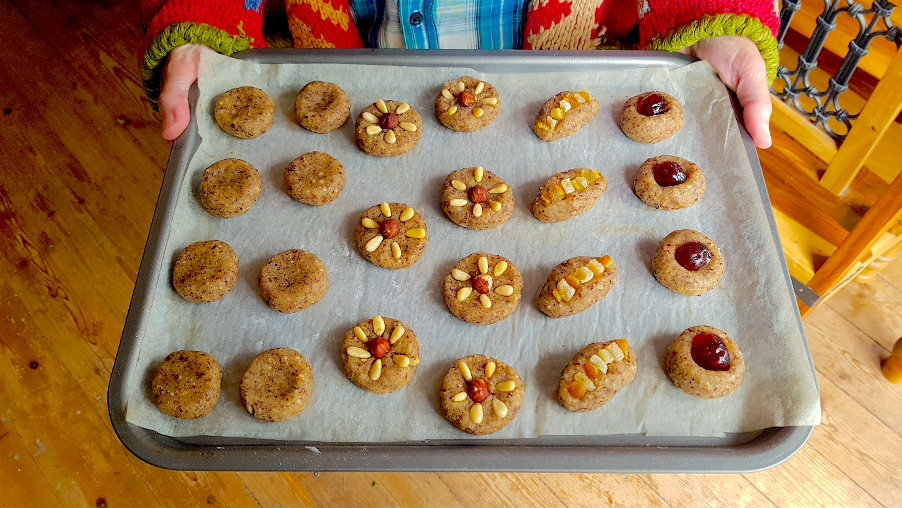
Petit four is French for ‘low oven’, from the days when chefs cooked everything in a wood fired oven. Tiny biscuits like these were baked as the oven was cooling down. They are good served with after dinner coffee, liqueurs and / or ice cream. These happen to be both dairy free and gluten free, but they do require egg. If you get the baking right, they should be crisp on the outside and slightly chewy/gooey on the inside.
Living in hope and getting ready for Christmas!
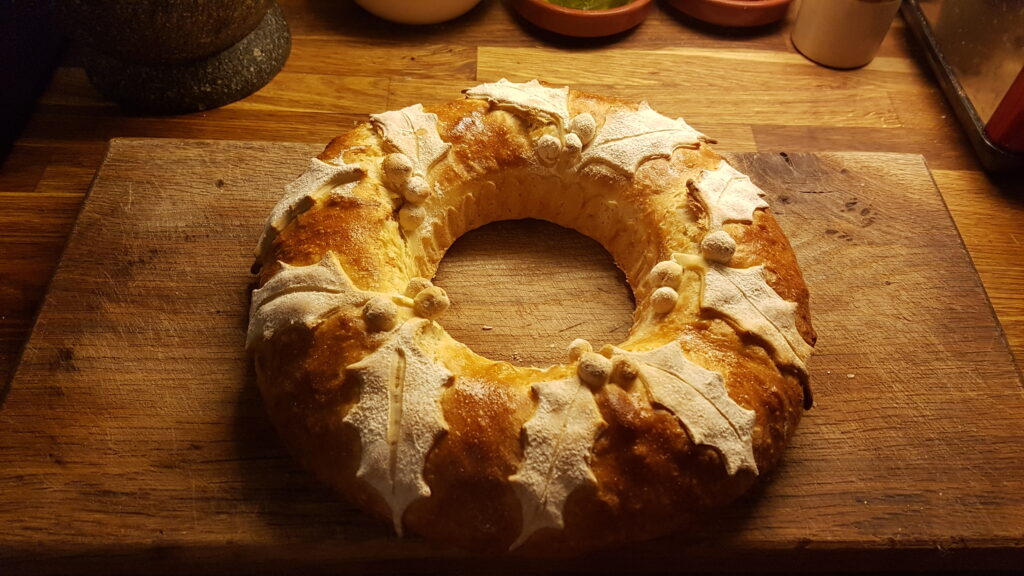
Who knows if we’ll all be together this Christmas?
As the November days get shorter and darker, I think it’s better to try and look on the bright side, even if we have to light candles at breakfast to do it.
With such positivity in mind, you might like to practise baking my very simple Holly Wreath. You can eat this delicious white bread still warm for your Christmas breakfast, or you can deck it with ribbons and hang it up to admire. Or do both and make several. It has the admirable benefits of being both very cheap to make, about £1.25 for ingredients, and , unusually for a Christmas item , completely sugar free.
The recipe is from our latest online course, Celebration Breads, due out in January. It is made from two kinds of dough: basic, yeasted white and what is somewhat alarmingly known as ‘dead dough’ i.e. dough made without yeast. The dead dough is used for the decorations, because it won’t rise and deform in the oven. I’ve used a simple holly leaf cutter here, but of course you can be as creative as you like. Ivy, pine cones, Christmas roses, angels and bells would all look lovely.
Ingredients
Main dough
- 600g white bread flour (Shipton Mill’s No.4 Organic)
- 390g water
- 6g Doves Farm instant yeast
- 12g fine sea salt
- 1 small egg
Decorative dough
- 150g white bread flour (or pastry flour)
- 25g double cream
- 55g water
- pinch salt
Materials
- Enough baking parchment to line your full-width oven tray.
- A round, non-stick dish or similar, to hold the shape in the middle of the wreath. I used a 12 cm mini quiche dish. Set this in the middle of the tray.
- Holly leaf cutter.
- Grignette or sharp knife.
- 1.5m ribbon (optional)
Method
- Make the main dough by measuring flour, salt and yeast into a medium-sized bowl.
- Add water and combine to form a dough.
- Knead (do 20 Rock & Rolls, if you’re familiar with our method) until smooth.
- Cover and set aside in a warm place for one hour.
- Make the decorative dough by combining all ingredients and kneading lightly. Cover and set aside.
- Once main dough has risen, take it out of the bowl and de-gas it, forming it into a neat boule.
- Take the cap off a bottle of wine (or similar) and plunge it into the centre of the boule to cut out a small hole. Put your fingers through the hole and rotate to enlarge the hole evenly all around. This will give you a wreath shape. Gently settle the wreath over the quiche dish on the baking tray.
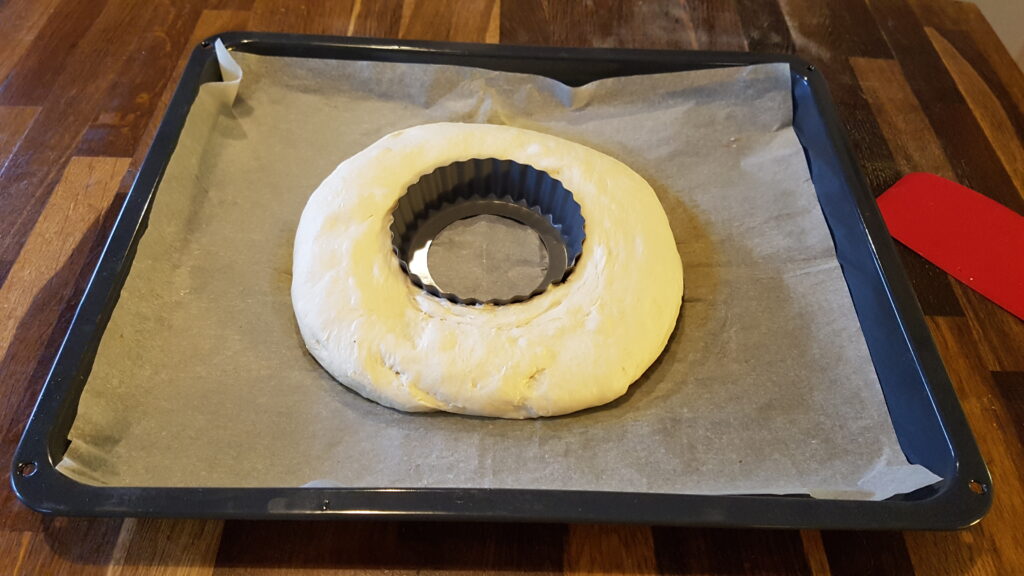
- 8. While the wreath is proving, roll the decorative dough out on a floured surface. Cut out holly leaves (I made 10), and score the leaf veins using a grignette. Take 15 pea-sized scraps of dough to roll into holly berries. Dust the leaves and berries with flour. Brush the wreath with egg. Pre-heat the oven to 200C.
- 9. Arrange the leaves and berries on the wreath. Bake for 25 minutes, turning in the oven half way to ensure even colour, and reducing the heat to 190C after the first 15 minutes.
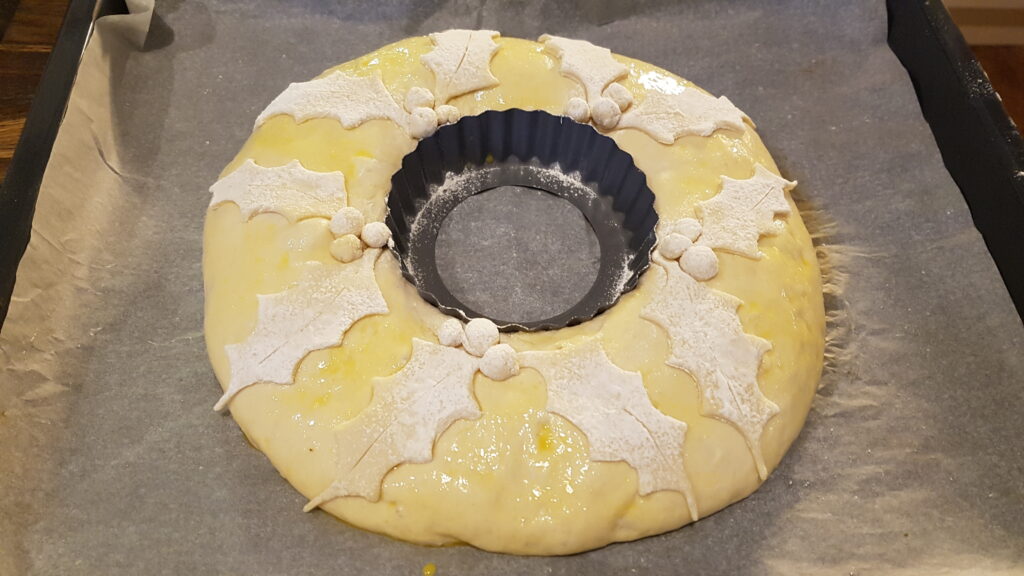
Cool slightly before serving. If you are going to hang it up with ribbon, let it cool properly first.
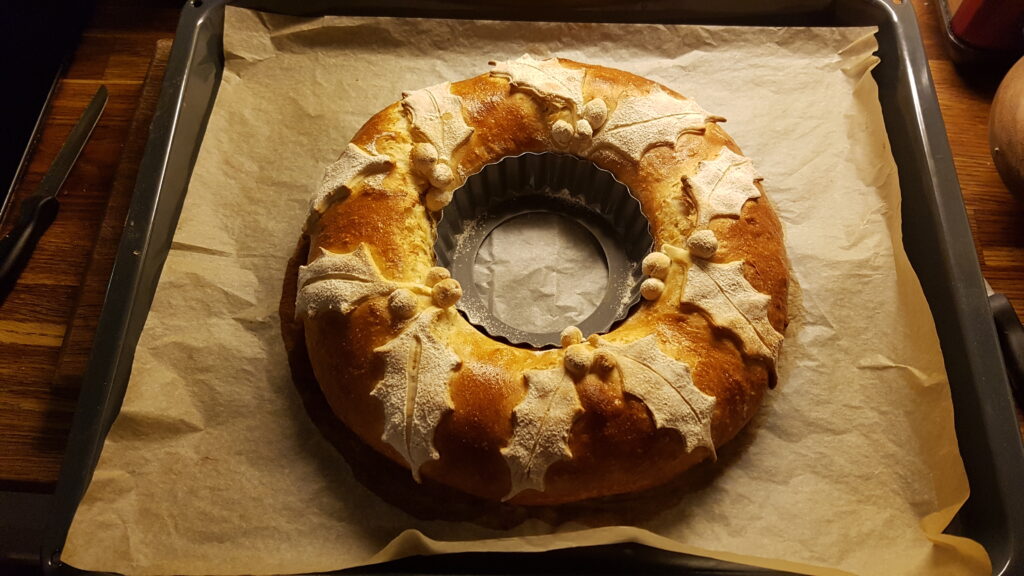
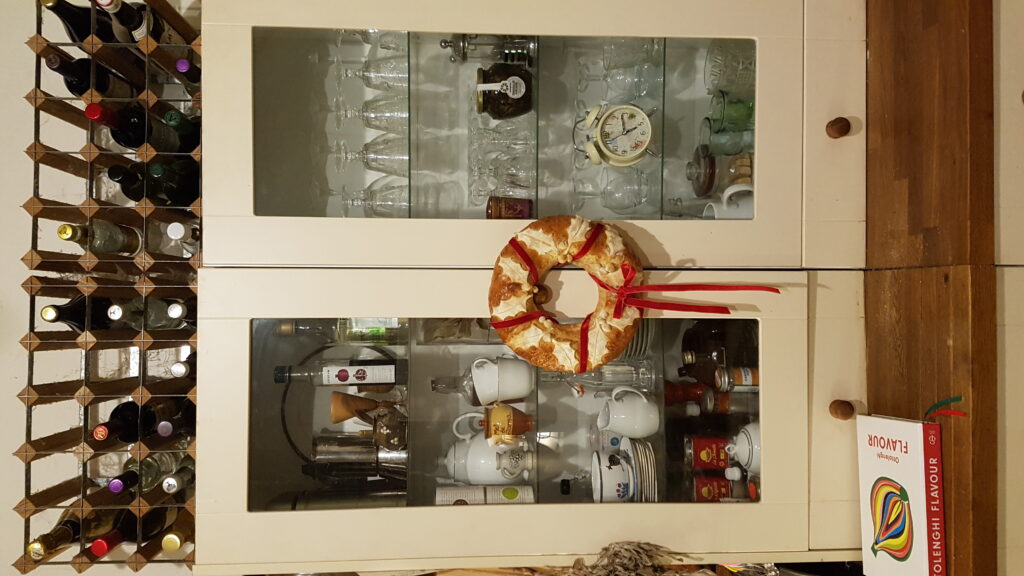
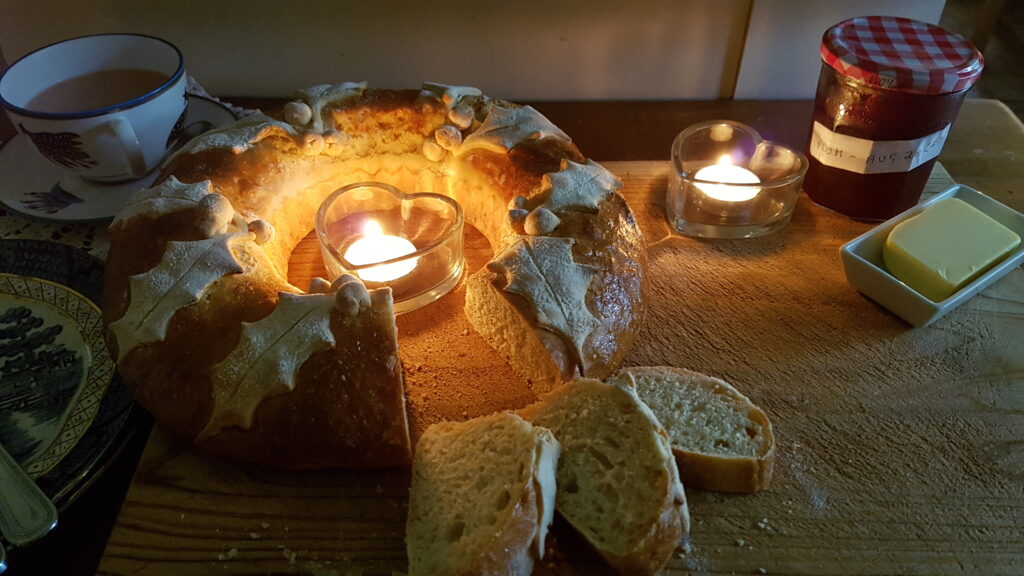
Harvest Festival

Thank you to Plympton Academy for ordering this wheat sheaf loaf. I love this time of year, and as bakers we are especially appreciative of the harvest and all that goes into it, so making this bread has special significance for me.
If you would like to order one, let me know. If you would like to bake one yourself, here’s the link to our video tutorial.
Happy Harvest!
Butternut Buns
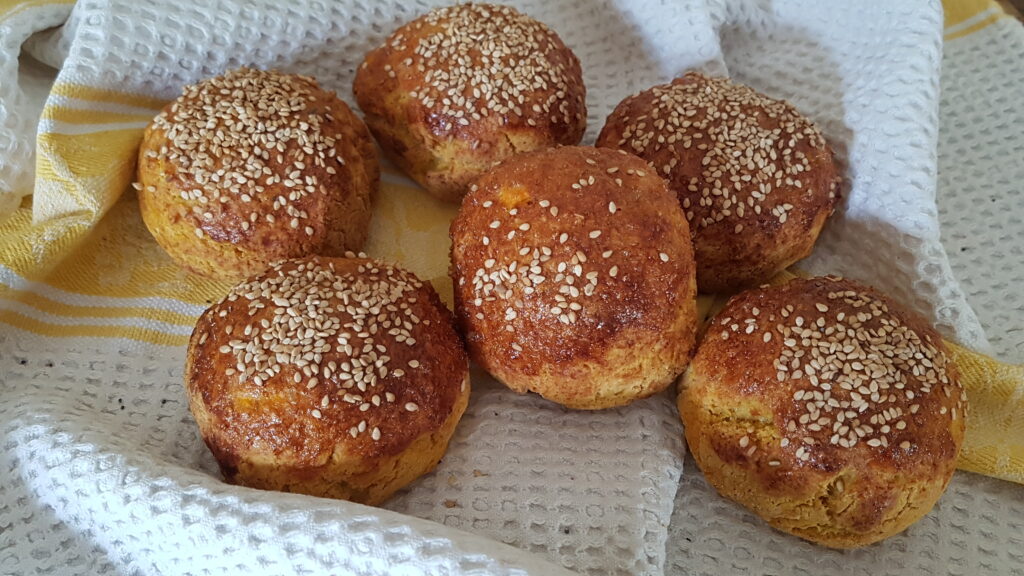
Make these instead of watching the news, and I promise you will feel much happier. (I do.)
As Lockdown 2.0 looms in the direr predictions of the tabloids, we all need something to take our minds off stir-crazy mayhem. These melt in the mouth bread rolls are vegan, gluten free and gorgeous-smelling! They’re made using our House White blend of gluten free flour, which you’ll be familiar with if you’ve done our GF courses. If you use a branded GF flour, make sure it doesn’t have any xanthan or other binder in it first, and increase the psyllium to 28g. Shipton Mill’s All Purpose Gluten Free Blend works very well here.
Of course, if you don’t happen to be vegan, you can use normal bread flour, dairy milk and butter, and honey. Whichever way you bake them, make the most of their brioche-like adapability, and serve them sweet, savoury or both at once; vegan cheddar and chilli jam are an excellent combo. Or you can add cinnamon and spice for a more autumnal flavour, and try using pumpkin instead of squash.
Whatever you do, these are comforting enough to take the edges off some rather tough times.
Ingredients
- 300g peeled butternut squash in chunks
- 360g oat milk or other plant milk
- 750g house white flour
- 100g vegan block
- 12g instant yeast
- 20g salt
- 35g agave or maple syrup
- 21g psyllium husk
- Poppy or sesame seeds to decorate

Method
- Cover squash in water in a pan, bring to boil and simmer for 15 minutes, until tender.
- Cool and mash.
- Weigh flour, yeast, salt and psyllium into a large bowl.
- Gently melt vegan block and syrup into milk in a small pan.
- Add mashed squash and milk mixture to flour in bowl.
- Mix to a smooth dough.
- Leave to rise for one hour – it will increase in volume by 20% – 30%.
- Divide into 120g portions for rolls, or roll into sausages to braid into a plaited loaf, or both.
- Brush with plant milk (or beaten egg for non-vegans).
- Sprinkle with poppy or sesame seeds.
- Prove for 30 minutes.
- Bake at 200 C 392F for 17 minutes (rolls) or 35 minutes (loaf).
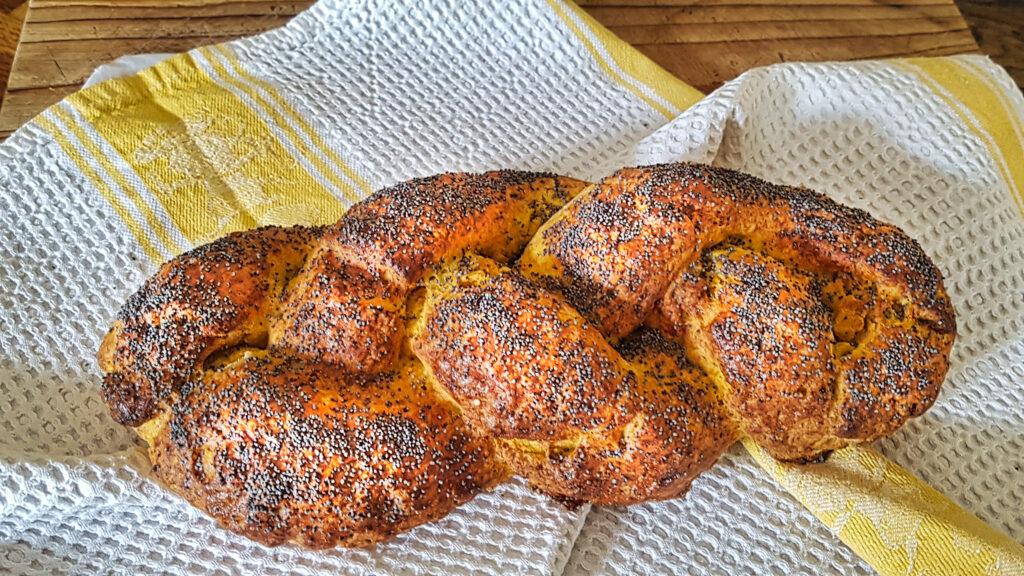
Back to School. (Hooray!)
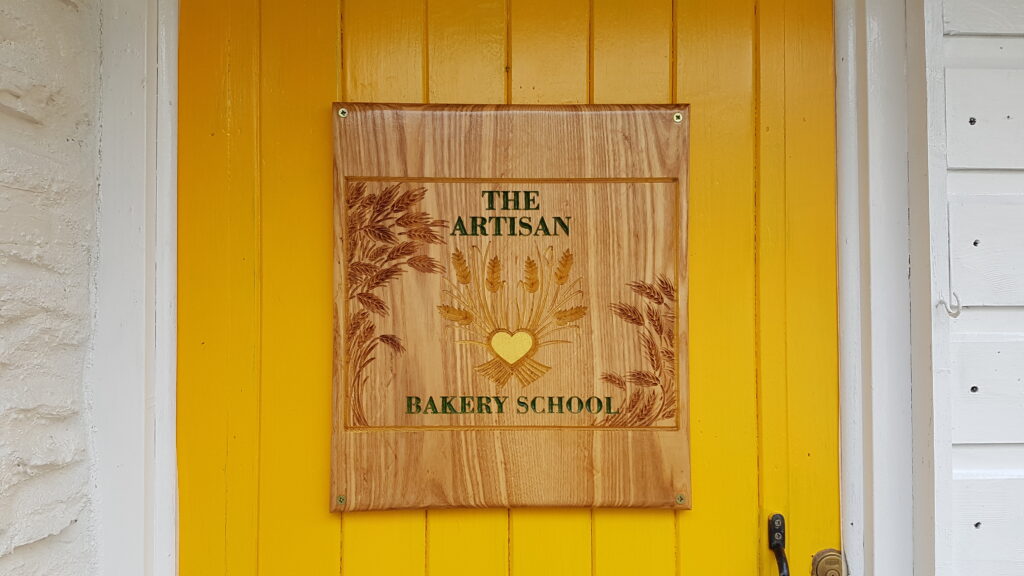
What do you think of our lovely yellow door? Our inventor/designer neighbour Tom carved us a new wooden sign with his laser thingummy-jig, and Penny spent some very happy hours painting and varnishing it, ready to welcome new students.
Indeed, with this summer seeing more of us planning a stay-cation, and more of us than ever baking our own breads, we reckon it’s the ideal time to come down to Devon and hone your skills here at The Artisan Bakery School.
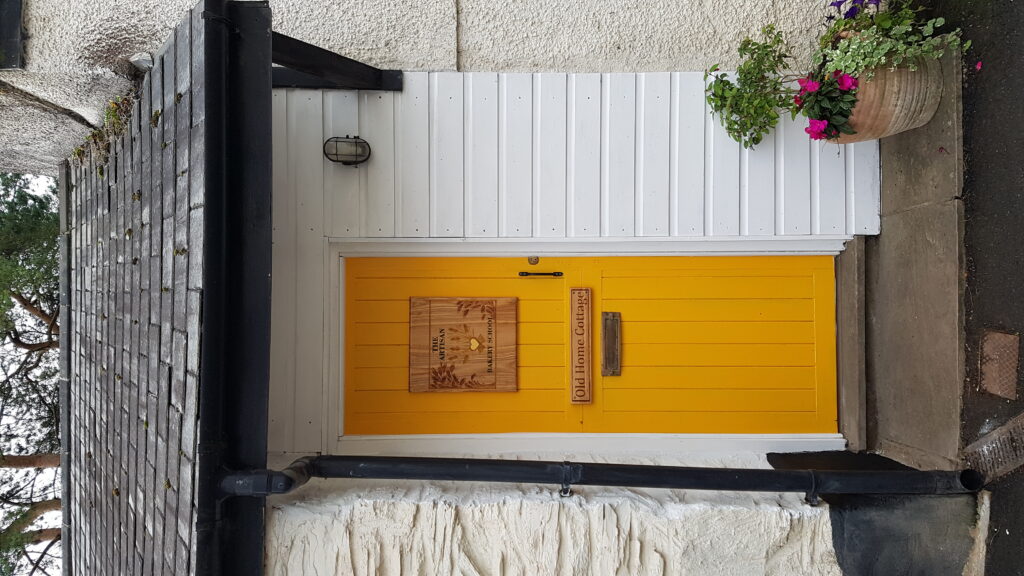
We have started running small classes again (4 students max.), and it’s a joy to see happy bakers up to their elbows in flour and fun. If you’d like to join in, or know someone else who might, please check out our Course Dates (with suggestions of lovely places to stay locally) and don’t forget our Gift Vouchers too.
If you don’t feel quite ready to travel or take a live class, there’s always the option of choosing one of our Online Baking Courses, which now include three different gluten free options too. Our latest, The Gluten Free Sourdough Masterclass was launched just today.
Yesterday, Sunday, we ran the Ancient & Heritage Grain Flours course, and I just wanted to say how delighted everyone was with the range of heritage wheat flours from Mike Pinard at Lodge Farm in Surrey. We used Orange Devon Rough Chaff, Red Lammas, Old Kent Red and Hen Gymro, as well as ancient einkorn, spelt and emmer. If you’re looking for more flavour, and more authentic sourdough bread, then do give these a try!
Baking Us Proud!
Our baking students around the world continue to impress us.
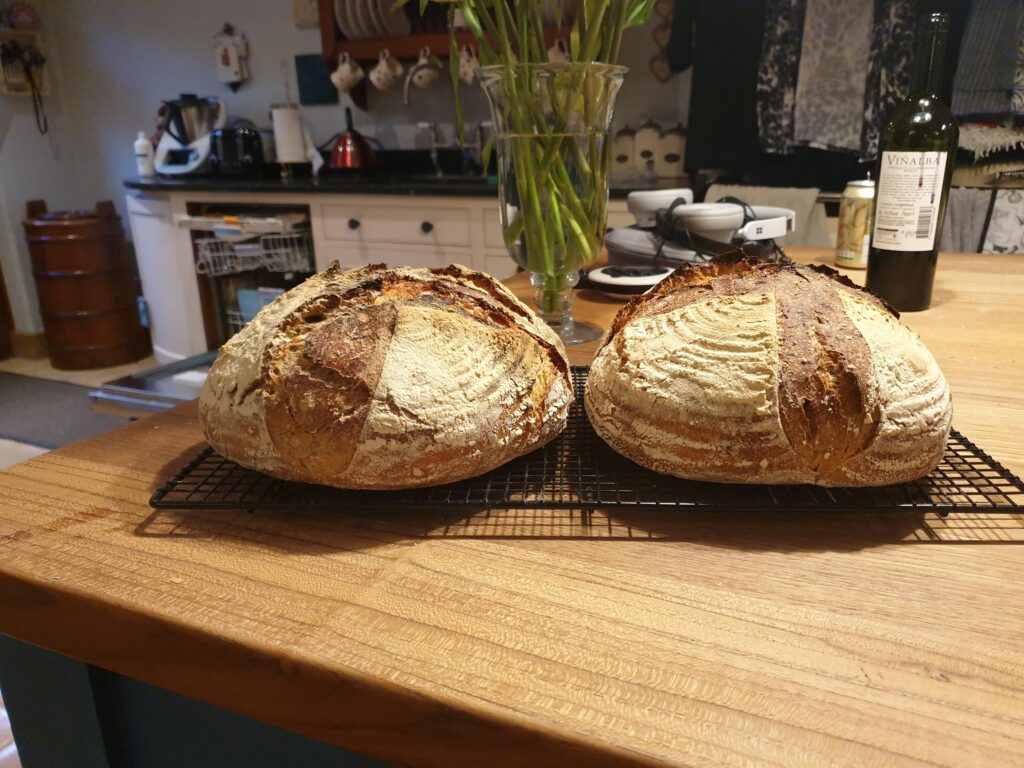
We have been teaching people how to bake real bread, pastries and pizza ever since the financial crisis in 2008…
Today, as we face an even bigger crisis for the world, now easing our way tentatively out of lockdown, our aim remains unchanged: to help individuals become more resilient and more self-reliant while pursuing a healthier lifestyle – and having fun! More than ever, we are convinced that traditional techniques, organic ingredients and ancient or heritage grains offer keys to a more caring and more sustainable society.
Our students, past and present, are doing us proud.

Those who learned to bake before the lockdown are putting their skills to good use, making bread for their own households, and helping their communities by baking for those in isolation, or baking for small community shops.
Those learning to bake online during lockdown are also highly motivated, sending us messages from all over the world, with questions about baking, and pictures of their beautiful loaves. It is heartwarming to see our interests shared by bakers from such diverse locations and situations!
Most popular online courses for lockdown have been Mastering Sourdough Starters & Leavens (No yeast? No problem!), Deliciously Gluten Free Artisan Bread, Naturally Gluten Free Sourdough Bread, Know Your Dough and Effortless Artisan breads.
Dr.John Tankard
I just wanted to say that what you both have given to me over the weekend Helen and I were able to stay last year, has paid off. I am by no means a expert, but now getting consistent results and now supplying the people local to us that are isolating.
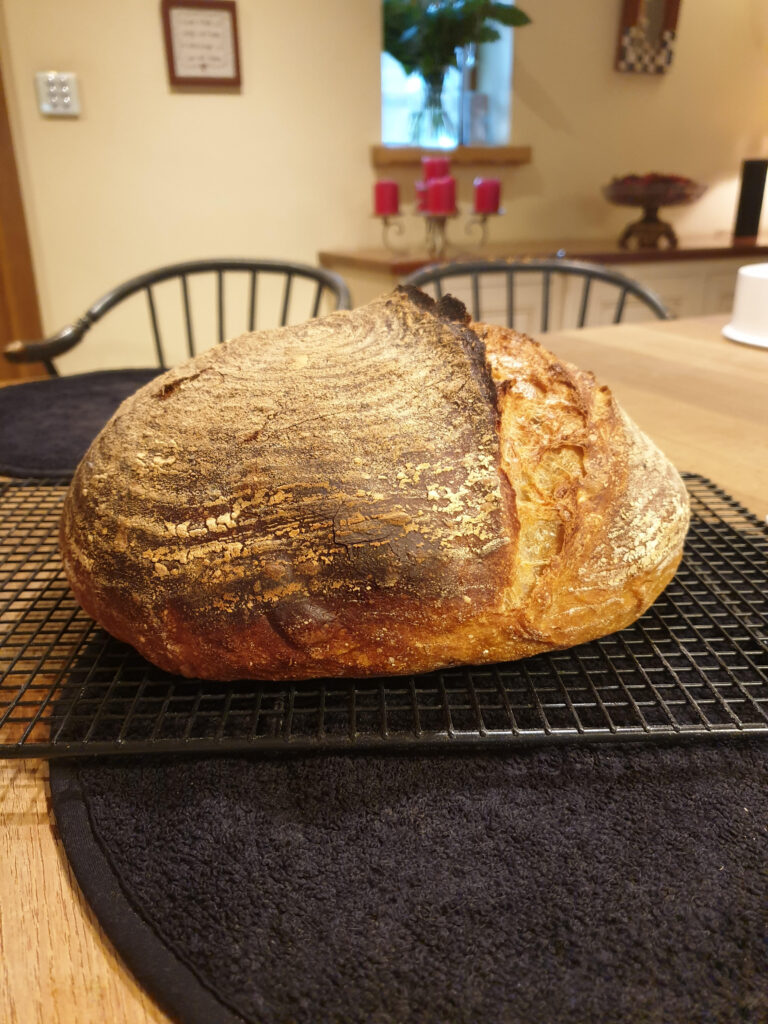
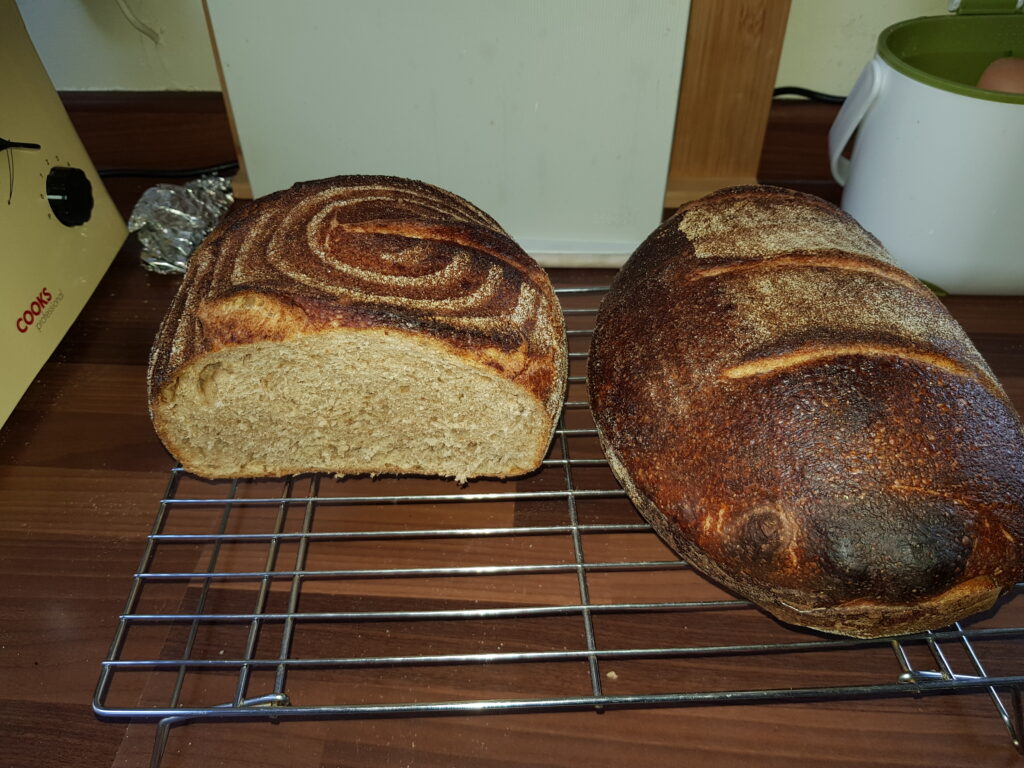
It has been 4 months since my induction into bread making. I just thought would send a few pics of my attempts (above). I noticed in your book that steam was not recommended in domestic ovens so I have been using casserole dishes which seem to work very well. (Great tip, John!)
John Morgan
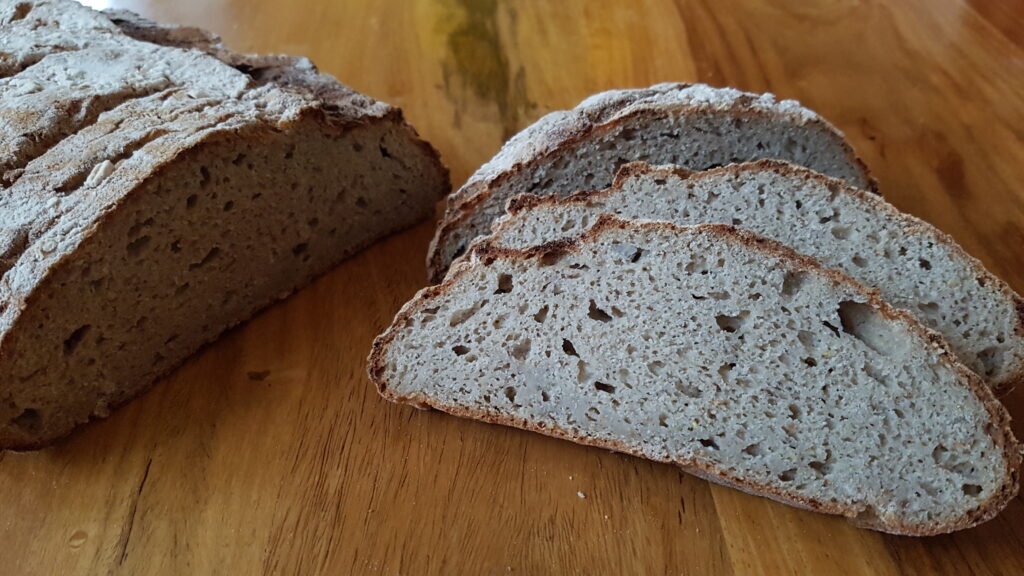
Naturally Gluten Free Chestnut and Buckwheat Bread
I made my own buckwheat starter from scratch, and am delighted it has worked! So I now alternate between the brown rice pizza boule recipe, and the buckwheat and chestnut loaf . I have started adding fennel seeds or cumin seeds, and topping with chia seeds, which has turned out well. I love baking gluten free with your recipes, it is a joy.
Judith Hooper – gluten free baking 2-day course
Online success
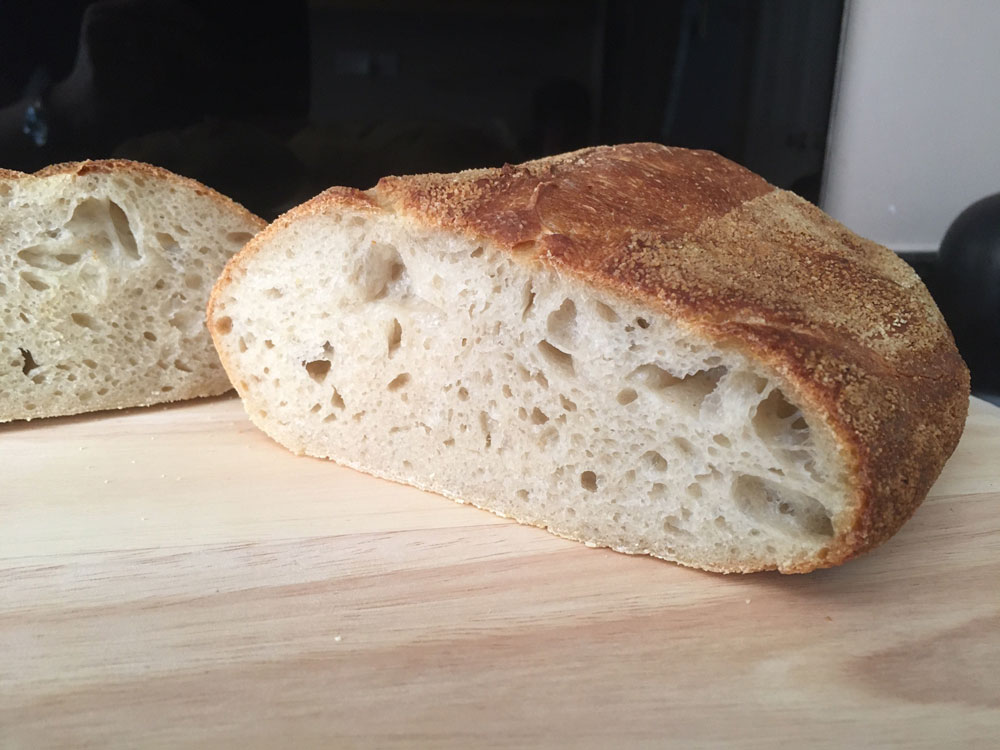
Ian Holt nails it first time. 
Boris Smajgel refused to give up – and look!
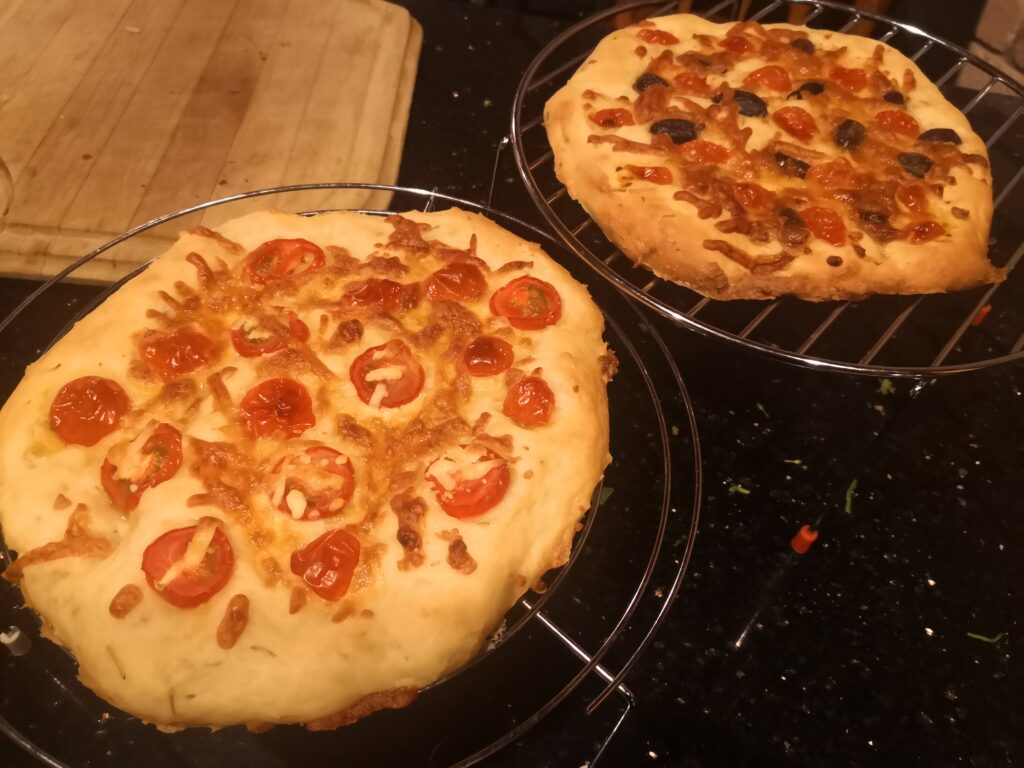
From Daniel Fracalossi, online student on Master the Craft of Artisan Pizza, in Hobart, Tasmania:
Dragan’s Dough:I think this is my favourite pizza recipe so far, the pizza puffs up really nicely and is thick enough to hold plenty of toppings. The flavour is also really nice, even though I only did the quick one (4 hours total fermentation time). I think this might have to be my go to recipe!
Focaccia Dough:This one was delicious too, very quick and a great treat. The added benefit of this one, is you can cook it in a regular domestic oven, even without a pizza stone! I haven’t tried baking it in my appliance yet, but it would probably go well as long as I used some baking paper. This is great for an appetiser 🙂 I made this for my parents and family when we visited them on the weekend and they were very impressed.
Rocket Pesto:We had lots of leftover rocket leaves in the house, so this was the perfect thing to make! We used it for pesto pasta for lunch during the week, which was delicious. I also put it on some of the pizzas using Dragan’s dough tonight.
Fossil Cove Track:Unrelated to pizza, but this was a walk that my wife and I did today, down to a little rock beach with a rock archway and fossils! We live in Hobart, Tasmania, so a fair way away from you in England!
Hope you both have had a nice week!

And on that note, we wish you all a great week too! Keep safe, keep happy and keep baking!
The Sub-Antarctic Sourdough Team!
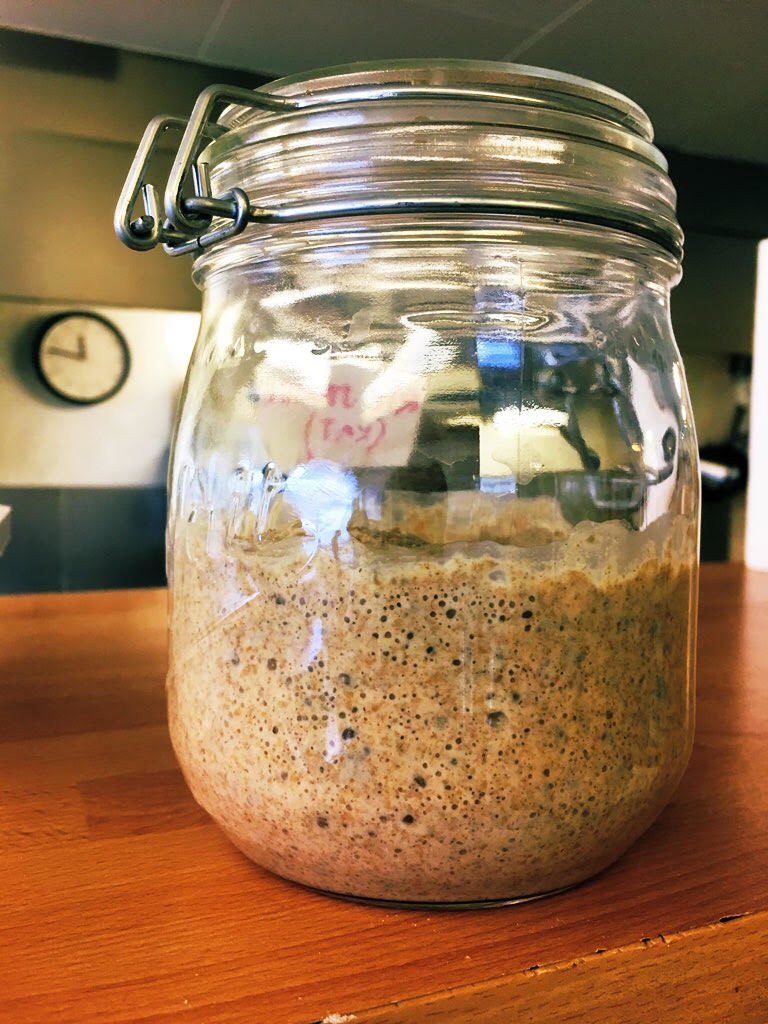
Possibly the world’s coolest bakers (including one trained by us)!
The South Georgia Islands lie just off Antarctica, and are home to a British Antarctic Survey base doing research on climate change. Last year, Dr. Katharine Ganly from Derriford Hospital arrived at The Artisan Bakery School having just read the fine print in her new employment contract which stipulated that all BAS team members must take turns baking bread for the base. “I had never baked bread before, and I had already accepted the job,” she joked, “so I thought I had better come and learn!”
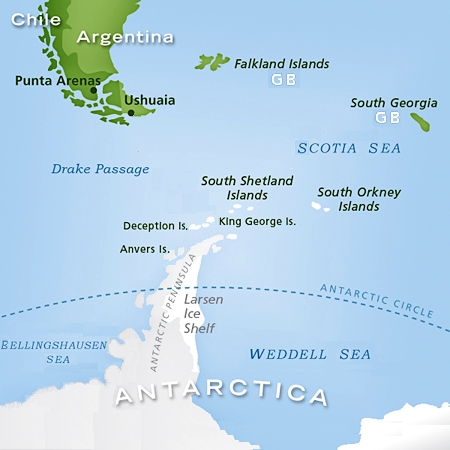
“Marcel is a true sub-Antarctic starter made here on South Georgia,” writes Katharine. “There is myself and another sourdough baker, the rest of the time it is usually bread made with packet yeast which is a bit quicker to make but also good. We eat a LOT of bread here- every day at 10:30 we have a break (called « Smoko » historically) where we manage to get through loaves of toast slices with jams and butter. I’m still here and will be here likely until December or January next year. We still have quite a full complement (27 on base at the moment) but will drop down to 10 next month. I’ll be doing more baking over the austral winter as my « turn » will come around more often. I am looking forward to it.
From over here life in the « real world » looks very strange. We have managed to remain the only continent free from coronavirus, but only by limiting polar operations. We are quite lucky in a way to be as geographically protected as we are, but we still get all the news and I think it makes people feel anxious here, worrying about others at home.”
“On a more positive note we have a King Penguin chick right outside my surgery here that was hatched only a few days ago. Quite a rare thing as usually they hatch in their colonies at locations remote to where we are- for some reason this pair have decided we are a good spot to raise a chick. I hope they are right and he gets fattened up before winter properly hits us here.”
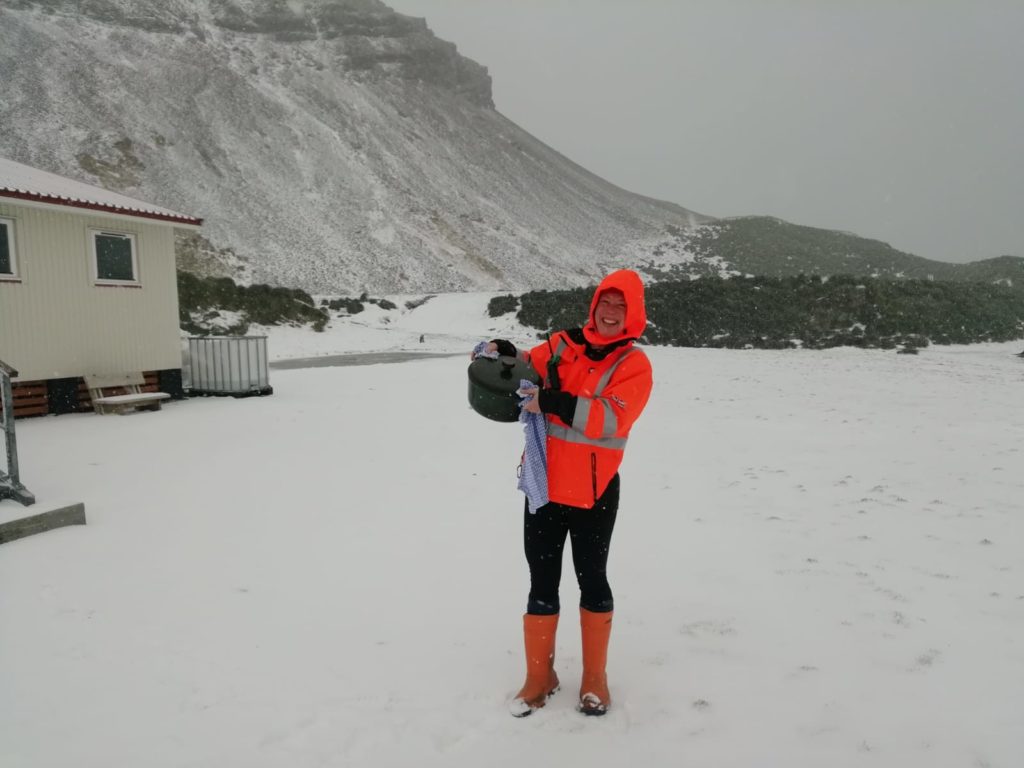
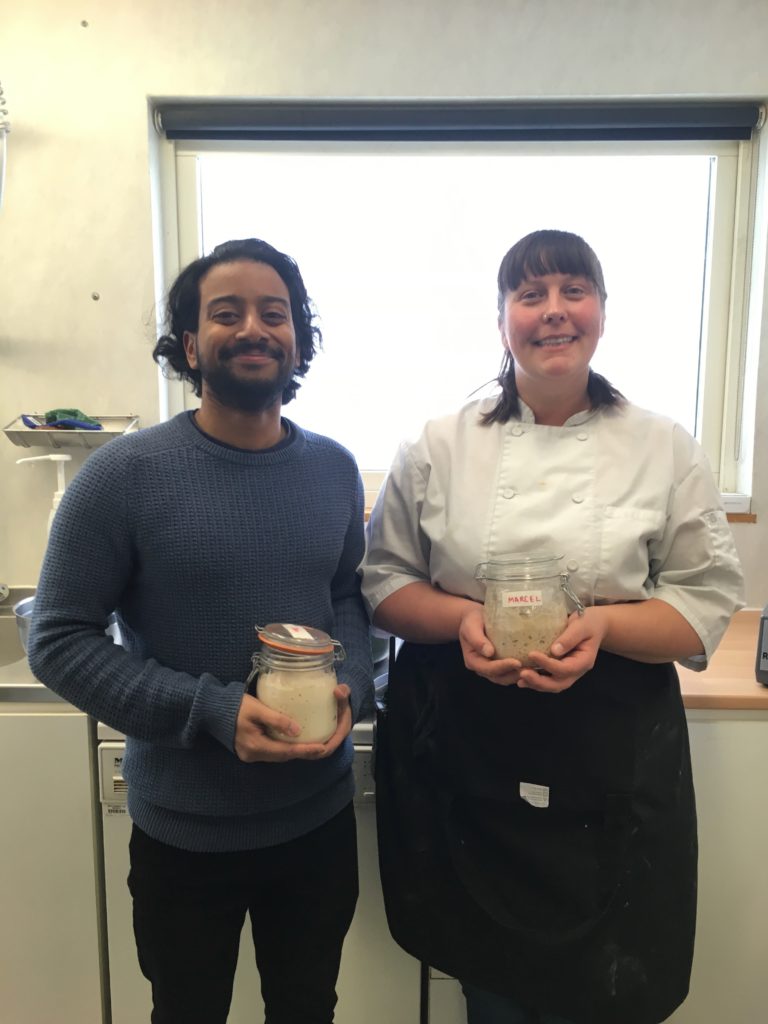
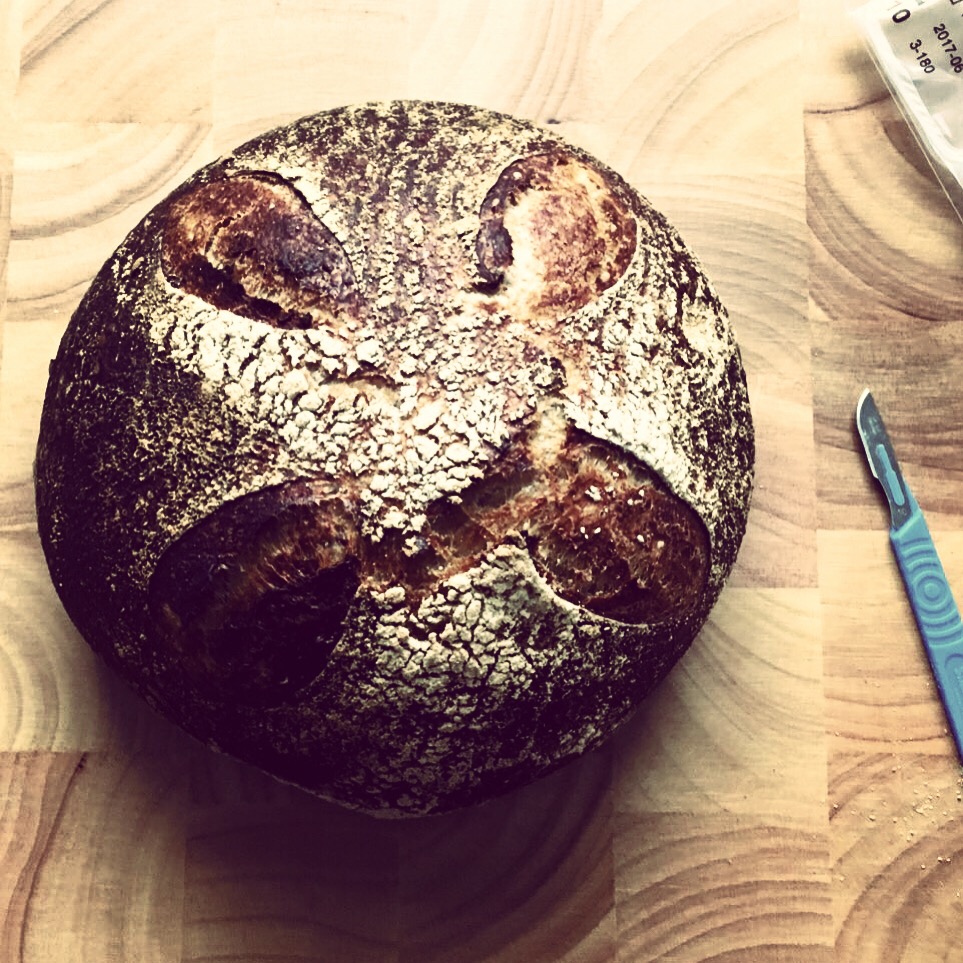
“It is strange to think that 8000 miles away we are probably more ‘social’ in our small community than everyone back home is able to be at the moment. I am baking two more loaves today/tomorrow but it is a rather ‘busy’ weekend for here with some boating to pick up colleagues who have been on a field trip to a different peninsula- this involves ‘all hands on deck’ so I prefer to reply now lest I forget to later. The picture (above) shows some bread I made yesterday ( excuse the scalpel in the photo- I use it to slash the dough before putting it in the oven!). “

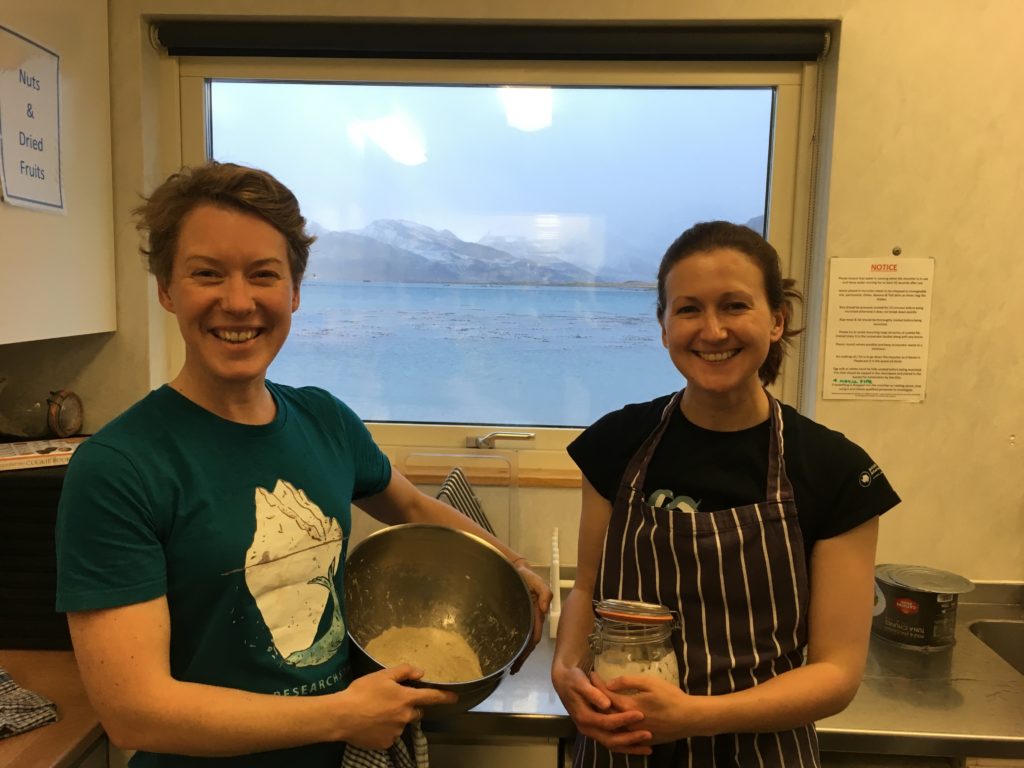
Please do feel free to use any photos on your blog/website for some positivity! I had wanted to take a picture of our penguin chick, but he is too shy at the moment and I don’t want to scare him off, so I have attached some others. I hope they all come through- our internet here is very limited at best.
With good wishes from South Georgia,
Katharine.”
Our thanks to Dr.Katharine Ganly and colleagues for the story, the lovely pictures and permission to share them with you.
Mayflower 400 and our Pilgrim Loaf
Four hundred years ago this September, the Pilgrim Fathers stepped aboard the Mayflower to sail for a new life in the New World. Last week, one remarkable American, Tamara Smith, made the journey back, all the way from Washington State to Sparkwell, Devon, UK.
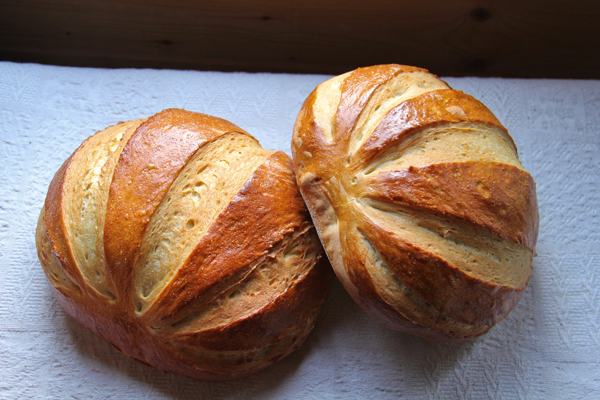
especially on the Chemin de Saint Jacques / Camino de Santiago.
Tamara came to do our 5-day Intensive Artisan Baker Course, with a view to expanding on her sourdough bread-making. She arrived in the middle of two storms (Ciara and Dennis), had her train cancelled at Taunton, and only reached us thanks to the kindness of a fellow passenger, a German physicist whom we have christened ‘Thomas the Angel’. (Hope you’re reading this, Tom!)

Our days were very full, with fellow students Mark, Sarah, and their 11-year old daughter Molly (top baker!) and David G. learning Artisan Bread for Beginners on Monday, and John M. joining us for Artisan Sourdough & Rye on Tuesday.
However, on Monday afternoon, I managed to take Tamara down to the Mayflower Steps in town, where the solid wall of drizzle reminded her of growing up in Seattle, and where the extracts from the journals of those aboard the Mayflower gave both of us a lump in our throats. If you know the sea, you know the courage it must have taken to make that voyage.

The vindication was, in a way, in the fact of us standing there together, two bakers from opposite sides of the Atlantic, united in their desire to bake truly great, healthy, wholesome and beautiful bread!

Jacka Baker, also on the Barbican, dates back to the early 1600s, and supplied ships biscuits for the Mayflower voyage. We did come to see you, too, guys, just a few minutes too late for Tamara to see the amazing breads you bake. Next time!
Our evenings were spent eating and drinking wine and telling stories around the fire, and what a lot we all had to tell. There’s not room to share it all with you here, but look out for Tamara’s name in the future; she’s a talented writer (and farmer/baker/property manager/home-schooler/stone chimney builder/winter postwoman/philospher/wit) with a lot to say. We barely stopped laughing for a moment. We made a bushel of pastries on the Viennoiserie Class, and some exceptional sourdough on the Heritage Grains day, but the most fun of all was the Wood Fired Pizza course on the very last day. Delicious pizza (as always), a few beers for thirsty bakers, and a great deal of hilarity.

Then Tamara, who had only come for the week, had to leave us, but not without her own Pilgrim loaf, and her sourdough starter culture (“Sparkwell”)!
The early settlers, I think, were homesick, and named their new settlements after their home towns: New York, New England, New Jersey. There are apparently around 650 English town names in the States, and sometimes they didn’t even bother with the ‘new’. If you’re local to us, you probably know there’s a Plymouth in Massachusetts. And now, we who bake in Sparkwell, Devon are proud to say that The Sparkwell Oven is soon to be built by Tamara’s husband, Trent, and opening in Washington, USA. Thus, the circle closes, a circle of transatlantic friendship and baking. To Tamara and Trent and their amazing Family, we wish you Godspeed in your venture, and every success!
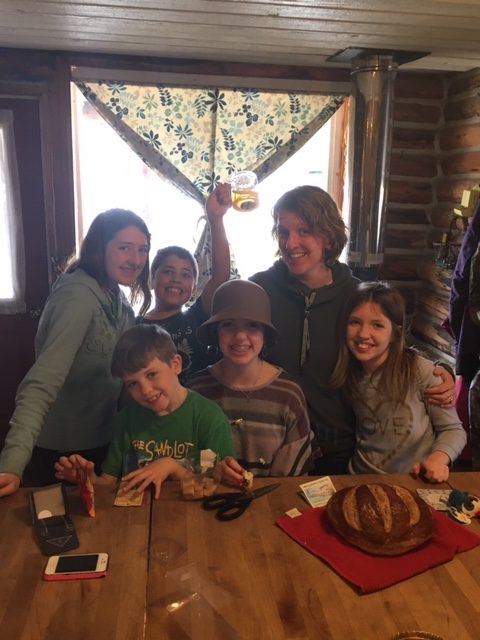
Opening soon in Washington, USA:
The Sparkwell Oven!
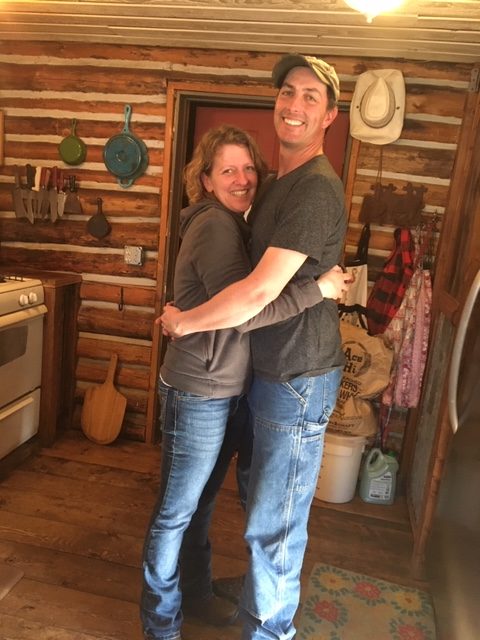
So long, bubble trouble!
Introducing our latest online course: Mastering Sourdough Starters & Leavens
The questions we get asked most often in our courses are about the mysteries of starters and leavens (and mothers and cultures and what-all else you like to call ’em). Even if you buy a starter, or get one from a friend, it’s hard to tell whether it’s healthy or not, unless you know what signs to look for. Which means people end up baking bad bread for months without knowing why. Recipe books rarely go into sufficient detail about the kind of leaven required for a loaf – old, mature, young? and so the results can sometimes be frustrating. What does ‘ripe leaven’ mean, after all?
So we came up with this online course for all our students; a focus on what sourdough starter culture is, how to make it, how to turn into leaven, and how to use it for baking different kinds of bread.
So, if you’ve been suffering from ‘bubble trouble’ – flat starter, low leaven, sad loaves, this ‘bubble bootcamp’ is the one for you! To get a free preview, and decide for yourself, just click here: Mastering Sourdough Starters & Leavens.
